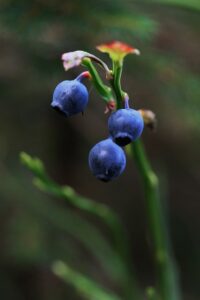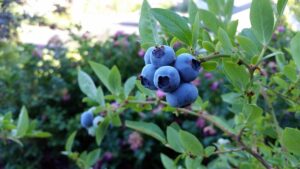Blueberries are full of nutrients and not inexpensive. With a little preparation you can learn how to grow blueberries in your yard or even in pots and have a supply of these tasty berries at your fingertips.

Choosing the Right Variety of Blueberry
Depending on your location’s climate and soil conditions, choose the appropriate blueberry bush variety. High-bush blueberries thrive in cooler climates, while rabbiteye and southern highbush blueberries are better suited to warmer climates.
Exploring Blueberry Varieties
-
- High-bush Blueberries: These are the most common variety found in cooler climates. They can grow up to 6-12 feet tall and produce large, juicy berries. High-bush blueberries need a long period of winter chill for optimal fruit production.
- Rabbiteye Blueberries: Named for their small, pink-to-red fruits that resemble a rabbit’s eye, these plants are heat-tolerant and thrive in the warmer southern United States. They grow up to 15 feet tall and require a different blueberry variety nearby for cross-pollination.
- Southern Highbush Blueberries: A hybrid of the high-bush and rabbiteye varieties, these plants are adapted to warmer climates with less winter chill. They grow 6-8 feet tall and produce medium to large berries. Southern highbush blueberries come in early, mid, and late-season varieties, extending the blueberry season for gardeners.
Southern highbush blueberries are a hybrid of the high-bush and rabbiteye varieties and do not require another variety for pollination. However, planting multiple varieties of blueberry bushes can help to extend the harvest season in your garden. For best results, choose two or more different varieties that flower at different times (early, mid, and late-season varieties). By planting different varieties of blueberry bushes that bloom at different times, you can ensure a long harvest season for your blueberries.
Planting Blueberry Bushes

When selecting a location for your blueberry bushes, choose an area that receives full sun and has well-drained soil. If possible, select an area with some shelter from strong winds. When measuring out the planting site, allow 5 feet of space between plants to ensure adequate airflow.
To get started, prepare the soil by adding organic matter such as compost and peat moss. As you dig holes for the blueberry bushes, mix organic matter into the soil at a rate of about 15 pounds per 100 square feet. Once the soil is prepared, place each bush in its hole and fill with soil until it is just below the root ball. Firmly pack soil around the roots to ensure good contact between them and the surrounding soil.
Understanding Planting Depth for Each Variety
High-bush Blueberries: For high-bush blueberries, dig a hole that is twice as wide as the root ball and deep enough so that the bush is planted at the same depth as it was in the nursery. This typically ranges from 18-20 inches deep. After planting, backfill the hole with a mix of soil and compost, ensuring the bush is firmly in place.
Spacing for each Variety
When considering the spacing of your blueberry plants, it’s important to note that while they do need room to grow, they also benefit from some proximity to other plants for cross-pollination. Here are the typical spacing requirements for each variety:
- High-bush Blueberries: These bushes should be planted about 4-5 feet apart in a row, with about 8-10 feet between rows. This allows adequate room for growth and easy access for care and harvesting.
- Rabbiteye Blueberries: Rabbiteye varieties need more space, with bushes typically spaced 6 feet apart in a row and about 10-12 feet between rows.
- Southern Highbush Blueberries: These should be planted around 3-4 feet apart in a row, with approximately 8 feet between rows. This spacing allows for good airflow and accessibility.
Remember, these are general guidelines and the specific spacing can vary based on the specific variety and growing conditions. Always check with a local extension service or nursery for the best advice for your specific situation.
Soil needs of Blueberries
Blueberries require well-drained soil for optimal growth as they are highly susceptible to root diseases caused by excessively wet conditions. The ideal soil depth for blueberries is about 20 inches, as deeper soil allows for efficient root development and improved access to water and nutrients.
Enhancing Soil Drainage
If your soil doesn’t drain well, consider implementing some strategies to improve its structure. Adding organic matter, such as compost or well-rotted manure, can improve soil fertility and drainage. Additionally, creating raised beds can significantly enhance soil drainage and prevent waterlogging. Raised beds elevate the soil level, allowing water to drain away more effectively and ensuring the roots are not sitting in water.
Soil Preparation
To test the pH of your soil, you can use a soil pH testing kit available at garden centers or online. After collecting samples from several different areas of your proposed planting site, mix them together and then follow the instructions provided with the kit. Alternatively, you can send your soil sample to a professional lab for a more detailed analysis.
If your soil’s pH level is higher than 5.5, you’ll need to amend it to make it more acidic for blueberries. Sulfur is commonly used to lower ph. You can add it in the form of elemental sulfur or aluminum sulfate, available in most garden centers. Peat moss is another alternative and it also improves soil structure, but be mindful of its environmental impact – peat bogs are important carbon sinks and their harvesting contributes to climate change.
Remember, changing soil pH is a gradual process and may take a few months. Retest your soil pH periodically to ensure it’s in the correct range and amend as needed. Always follow package instructions when applying these amendments to avoid damaging your plants.
Watering Blueberry Plants
Choosing the right method of watering is paramount for the health and productivity of your blueberry bushes. Drip irrigation or soaker hoses are often recommended, as they deliver water directly to the root zone, reducing water waste and limiting the spread of fungal diseases that can develop in damp foliage. Watering in the early morning hours helps minimize evaporation and ensures your plants have sufficient water to cope with the heat of the day. As a rule of thumb, blueberries require 1 to 2 inches of water per week. Make sure to adjust your watering based on rainfall and temperature – less watering is needed during wet periods and more during dry, hot spells. Always aim to keep the soil consistently moist but never allow it to become waterlogged as this can promote root diseases.
Fertilizing for Blueberries
Blueberries are light feeders and usually require limited amounts of fertilizer. If necessary, feed your plants with a balanced fertilizer such as 10-10-10 once a year in early spring when the buds swell. For established blueberry bushes, organic fertilizers like aged manure or compost are recommended over synthetic fertilizers, as these are less likely to burn delicate roots. Always follow package instructions carefully and stop fertilizing at least three weeks before harvest to avoid tainting the fruit. If you notice signs of nutrient deficiencies such as yellowing leaves, a soil test can help determine what amendments need to be added to ensure your plants receive the nutrients they require.
When it comes to enhancing your blueberry bushes’ growth and productivity, proper fertilization is key. Using a fertilizer specifically designed for acid-loving plants, such as a rhododendron or azalea fertilizer, can provide the right balance of nutrients your blueberries need.
Timing Fertilizing of Blueberry Plants
The first application should take place in early spring as the buds begin to break. This initial feeding kickstarts the plant’s growth after a dormant winter period and supports the development of new leaves and berries. A second application in late spring, usually around the time of bloom, helps sustain the plant during the crucial fruiting phase.
How to Apply Fertilizer
To apply the fertilizer, spread it evenly around the base of the blueberry bush, avoiding direct contact with the plant’s stem to prevent burning. The fertilizer should be spread out to just beyond the drip line, which is the farthest point that branches and leaves extend from the plant. This is where most of the active, nutrient-absorbing roots are located.
Monitoring and Adjusting
It’s also important to monitor the health and growth of your plants to determine if additional fertilization is needed. Signs of nutrient deficiencies include yellowing leaves (possible nitrogen deficiency) and stunted growth (possible phosphorus deficiency). If these signs appear, additional fertilization may be needed. Over-fertilization, on the other hand, can be just as harmful, causing salt burn and excessive vegetative growth at the expense of fruit production. Always remember that with fertilizers, more is not necessarily better.
By understanding the needs of your blueberry bushes and providing them with the right fertilizing regimen, you can ensure they produce a bountiful harvest year after year.
My blueberry bushes all kept dying after a year or two. I tried various fertilizer and acidifiers. This product from Amazon is what finally seemed to work.
Fertilome (10665) Soil Acidifier Plus Iron (1 gal)
You just mix 2 TBS/Gal. of water in 5 Gal. bucket. Makes blueberries very happy!
Pruning Blueberry Bushes
Pruning is best done in late winter or early spring. Remove all dead wood and weak branches to allow for new growth. Pruning is a critical part of maintaining the health and productivity of your blueberry bushes. When pruning, focus on removing old and woody stems that are over 5 years old. These older stems become less productive and pruning them encourages the growth of new, more fruitful branches. Additionally, any diseased or broken branches should be removed to prevent the spread of disease and to aid the plant’s overall development. Every year about 20% of the older canes should be pruned.
To prune effectively, use sharp, clean tools to make clean cuts close to the base of the stem, but avoid damaging the crown of the plant where new growth emerges. Remember, the goal is to open up the plant to better light penetration and air circulation, as well as to maintain a balance between vegetative growth and fruit production. With the right pruning techniques, your blueberry bushes will be more vigorous, healthier, and will produce a higher yield of berries.
Pest and Disease Management for Blueberries
Regularly inspect plants for signs of disease or pests. Use eco-friendly pesticides if necessary.
Diseases and Pest Symptoms of Blueberry Plants
Blueberry bushes can be susceptible to a range of diseases and pests. Common diseases include fungal infections like Anthracnose, which causes dark, sunken lesions on berries, and Mummy Berry, which turns berries into hard, shriveled, “mummy-like” fruits.
Recognizing Leaf and Berry Symptoms in Blueberries
Observing the leaves and berries of your blueberry bushes can provide invaluable insights into their health. Brown spots on the leaves or berries could indicate a fungal infection, such as Septoria leaf spot or Botrytis fruit rot. Similarly, rust spots are typically a sign of rust fungus, a disease that can weaken your bush over time if left untreated.
- Leaf Tip Issues: Browning leaf tips often symbolize a problem with the plant’s water supply, either over or under watering. It can also be a sign of nutrient deficiency, particularly nitrogen.
- Yellow Spots: The presence of yellow spots on blueberry leaves usually indicates an issue with the plant’s iron uptake, commonly referred to as iron chlorosis. This condition, often caused by high soil pH or poor drainage, can hinder the plant’s ability to produce chlorophyll, leading to the yellowing of leaves.
- Rust Spots: Reddish-brown rust spots on leaves are often a sign of rust fungus, which can spread to other parts of the plant and weaken it over time if left untreated.
- Berry Splits: Splitting or cracking of berries is usually caused by rapid changes in temperature or too much water. It’s best to try and protect your blueberry bushes from sudden shifts in weather conditions.
Spider Mites are common pests of blueberry bushes that can quickly damage plants if left unchecked. They appear as tiny, eight-legged creatures with red, black, or yellow bodies. To identify an infestation, look for webbing on the underside of leaves and discoloration of the foliage. Regularly checking your blueberries for signs of spider mites is important to prevent damage.
Blueberry Maggots are a type of fly larvae that feed on blueberry fruit and can cause serious damage to the crop. These white, legless creatures range in size from 1/10th to 1/4th of an inch long, and often have a black spot at the head end. You can usually identify an infestation by finding the maggots inside of damaged fruit.
Blueberry Bud Moths are small moths that feed on flower buds and can cause severe damage to blueberry crops, particularly when they lay their eggs inside the buds. The larvae are white caterpillars with black heads and brown spiracles down their backs. Adult moths can be identified by their grayish-brown color and distinctive white markings. Regular monitoring for these pests is important to keep them in check.
In addition, other + bushes include aphids, leafrollers, sawflies, and root weevils. Aphids are small sap-sucking insects that can cause distorted growth on leaves and fruit. Leafrollers are insects that roll up leaves to feed and pupate on them. Sawflies are small wasp-like insects that lay their eggs in leaf tissue, leading to skeletonized foliage. Root weevils often cause damage to the roots of blueberry bushes by feeding on them.
Treatment of Blueberry Bush Pest
Spider Mite Treatment
Spider mites can be controlled using a variety of strategies. One of the most effective methods is the use of predatory insects like ladybugs or lacewings, which naturally prey on spider mites. For severe infestations, a miticide may be necessary. Be sure to carefully follow the manufacturer’s instructions when applying.
Blueberry Maggot Treatment
If blueberry maggots are detected, you can use yellow sticky traps to catch and monitor the adult flies. Insecticides can also be applied to the soil around the plants to kill the larvae. Proper sanitation practices, like removing and destroying infested fruit, can also help prevent reinfection.
Blueberry Bud Moth Treatment
Blueberry bud moths can be managed by applying a targeted insecticide when the first moths are observed. Be sure to spray the entire plant, particularly the buds, to ensure thorough coverage. It is also beneficial to remove any plant debris from previous seasons to disrupt their lifecycle.
Aphid Treatment
Aphids can be controlled using a variety of methods including insecticidal soaps, horticultural oils, or beneficial insects like ladybugs and lacewings. Regular monitoring and early treatment can help manage aphid populations.
Leafroller Treatment
Treatment for leafrollers includes the use of insecticides or biological controls like parasitic wasps. Removing and destroying rolled leaves can also help manage populations and prevent spread.
Sawfly Treatment
Sawflies can be controlled manually by removing and destroying affected foliage. For larger infestations, an application of a suitable insecticide may be necessary.
Root Weevil Treatment
Root weevils can be difficult to control once established. Beneficial nematodes can be introduced to the soil to parasitize the weevil larvae. Infected bushes may also need to be treated with an appropriate insecticide.
Rust Fungus
Rust fungus can be managed by keeping plants well watered and pruned of dead or dying material. Applying a fungicide to the affected foliage may also help control growth. Pruning of infected branches should always be done before new growth begins in the spring.
Septoria Leaf Spot or Botrytis Fruit Rot
Septoria leaf spot or Botrytis fruit rot are two other common fungal diseases that attack blueberry bushes. Treatment for both entails the removal of any dead or diseased branches as well as the application of a fungicide to help control spread. Regular monitoring throughout the season can also help protect against these and other diseases.
Growing blueberries successfully requires paying close attention to pest and disease issues throughout the season.
Preventing Future Diseases
The best way to manage blueberry diseases is to be proactive and take preventive measures against infection. Here are some tips for keeping your plants healthy:
- Employ good gardening practices, such as removing weeds, promoting air circulation around the plants, and cleaning up any fallen leaves or fruit from the ground below
- Utilize mulch to keep the soil temperature consistent and retain moisture levels
- Plant your blueberry bushes in nutrient-rich, well-draining soil
- Water blueberries slowly and deeply when dry conditions exist
- Prune plants regularly to improve air circulation and remove diseased branches or canes
- Avoid overhead irrigation, as this can increase the spread of fungal diseases
- Try to protect your blueberry bushes from sudden shifts in weather conditions
- Test soil regularly and use fertilizer or soil amendments to replenish nutrient levels when needed.
By following these steps, you can help ensure that your blueberry bushes stay healthy and productive for many years. Additionally, it’s important to inspect your plants regularly for any early signs of disease, such as discolored leaves or weakened canes. If you catch a problem early on, it will be much easier to manage with minimal damage to your plants.
Protecting Blueberries from Birds
Birds pose a significant threat to blueberry crops as they are attracted to the ripe, sweet berries. To protect your blueberry bushes from bird damage, consider the following strategies:
- Netting: This is the most effective method for protecting your blueberries. Just be sure to buy a type of netting that won’t trap and kill the birds. Cover your bushes with bird netting when the berries start to ripen, ensuring the netting is secure so birds cannot get under it.
- Visual deterrents: Hang shiny objects that move in the wind around your garden, such as CDs or aluminum foil strips, to scare off birds.
- Noise deterrents: Devices that produce sudden, loud noises can deter birds from approaching your bushes. These can be as simple as wind chimes or as complex as ultrasonic devices.
- Garden decoys: Placing decoys, like plastic owls or hawks, near your blueberry bushes can help deter smaller birds.
- Taste aversion: There are non-toxic sprays available that taste unpleasant to birds. Spraying this on your berries can deter birds from eating them.
Remember, it’s important to implement these strategies as soon as your blueberries begin to ripen. The longer you wait, the more likely birds will discover your bushes and start feasting on your fruit.
Taking the time to properly protect your blueberry bushes from birds will help ensure that you get the most out of your harvest.
If you are interested in being more self-sufficient check out this book. I like this series.
Harvesting Blueberries

Blueberries will typically be ready to harvest between July and August. They should be fully blue with a slight silver sheen. Gently twist the berries off the stem and be careful not to bruise them. Place the harvested blueberries in a single layer in a shallow container and store in your refrigerator at around 35-40 degrees Fahrenheit.
When you’re ready to enjoy your fresh blueberries, it’s essential to ensure they are clean and safe for consumption. Wash them under cold water, gently removing any dirt or debris. Inspect the berries carefully and remove any that show signs of damage or mold. Once they are clean and sorted, you can enjoy them as a healthy snack, add them into desserts or blend them into a nutritious smoothie. The possibilities are endless!
Conclusion:
Remember, patience is key as blueberry bushes may take a few years to produce a substantial harvest. With the right care and protection, you can ensure that your blueberries will be safe from birds and ready to pick come harvest time. Happy growing!
You can also take advantage of harvesting your blueberries for other creative uses. Whether it’s freezing them for later use or preserving them in a jar of honey, you can have fun experimenting with different recipes that involve blueberries. With a little practice and care, you can enjoy the rewards of your labor for many years to come!
If you’re looking for a fun and rewarding activity, planting blueberry bushes is an excellent choice. Not only are blueberries tasty treats but they are also packed with essential vitamins and minerals that can contribute to a healthy diet. With the tips outlined above, you’ll be able to get started growing beautiful, delicious blueberries in no time!
For more information on general gardening check here.
For more information on growing vegetables click here.
For more on home orchards click here
Resource:
https://www.almanac.com/growing-blueberries-plant-all-seasons

